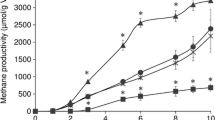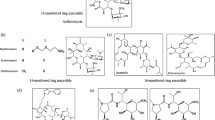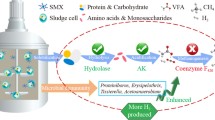Abstract
In the methane production from waste activated sludge (WAS), complex bacterial interactions in WAS have been known as a major contribution to methane production. Therefore, the influence of bacterial community changes toward methane production from WAS was investigated by an application of antibiotics as a simple means for it. In this study, azithromycin (Azm) as an antibiotic was mainly used to observe the effect on microbial changes that influence methane production from WAS. The results showed that at the end of fermentation, Azm enhanced methane production about twofold compared to control. Azm fostered the growth of acid-producing bacterial communities, which synthesized more precursors for methane formation. DGGE result showed that the hydrolysis as well as acetogenesis stage was improved by the dominant of B1, B2 and B3 strains, which are Clostridium species. In the presence of Azm, the total population of archaeal group was increased, resulting in higher methane productivity achievement.




Similar content being viewed by others
References
Rocher M, Goma G, Begue AP, Louvel L, Rols JL (1999) Towards a reduction in excess sludge production in activated sludge processes: biomass physicochemical treatment and biodegradation. Appl Microbiol Biotechnol 51:883–890
Yoshida H, Tokumoto H, Ishii K, Ishii R (2009) Efficient, high-speed methane fermentation for sewage sludge using subcritical water hydrolysis as pretreatment. Bioresour Technol 100:2933–2939
Yan S, Miyanaga K, Xing X-H, Tanji Y (2008) Succession of bacterial community and enzymatic activities of activated sludge by heat-treatment for reduction of excess sludge. Biochem Eng J 39:598–603
Li X, Ma H, Wang Q, Matsumoto S, Maeda T, Ogawa HI (2009) Isolation, identification of sludge-lysing strain and its utilization in thermophilic aerobic digestion for waste activated sludge. Bioresour Technol 100:2475–2481
Kim Y-K, Bae J-H, Oh B-K, Hong Lee W, Choi J-W (2002) Enhancement of proteolytic enzyme activity excreted from Bacillus stearothermophilus for a thermophilic aerobic digestion process. Bioresour Technol 82:157–164
Neyens E, Baeyens J, Weemaes M, De Heyder B (2003) Pilot-scale peroxidation (H2O2) of sewage sludge. J Hazard Mater 98:91–106
Weemaes M, Grootaerd H, Simoens F, Verstraete W (2000) Anaerobic digestion of ozonized biosolids. Water Res 34:2330–2336
Bougrier C, Carrère H, Delgenès JP (2005) Solubilisation of waste-activated sludge by ultrasonic treatment. Chem Eng J 106:163–169
Kepp U, Machenbach I, Weisz N, Solheim OE (2000) Enhanced stabilisation of sewage sludge through thermal hydrolysis—three years of experience with full scale plant. Water Sci Technol 42:89–96
Li H, Jin Y, Mahar R, Wang Z, Nie Y (2008) Effects and model of alkaline waste activated sludge treatment. Bioresour Technol 99:5140–5144
Vlyssides AG, Karlis PK (2004) Thermal-alkaline solubilization of waste activated sludge as a pre-treatment stage for anaerobic digestion. Bioresour Technol 91:201–206
Nah IW, Kang YW, Hwang K-Y, Song W-K (2000) Mechanical pretreatment of waste activated sludge for anaerobic digestion process. Water Res 34:2362–2368
Valo A, Carrère H, Delgenès JP (2004) Thermal, chemical and thermo-chemical pre-treatment of waste activated sludge for anaerobic digestion. J Chem Technol Biotechnol 79:1197–1203
Mohd Yasin NH, Fukuzaki M, Maeda T, Miyazaki T, Maail C, Ariffin H, Wood TK (2013) Biohydrogen production from oil palm frond juice and sewage sludge by a metabolically engineered Escherichia coli strain. Int J Hydrogen Energy 38:10277–10283
Mohd Yusoff MZ, Hu A, Feng C, Maeda T, Shirai Y, Hassan MA, Yu C-P (2013) Influence of pretreated activated sludge for electricity generation in microbial fuel cell application. Bioresour Technol 145:90–96
Kanai M, Ferre V, Wakahara S, Yamamoto T, Moro M (2010) A novel combination of methane fermentation and MBR—Kubota submerged anaerobic membrane bioreactor process. Desalination 250:964–967
Buczkowska A, Witkowska E, Górski Ł, Zamojska A, Szewczyk KW, Wróblewski W, Ciosek P (2010) The monitoring of methane fermentation in sequencing batch bioreactor with flow-through array of miniaturized solid state electrodes. Talanta 81:1387–1392
Miyamoto K (1997) Renewable biological systems for alternative sustainable energy production. Food and Agriculture Organization of the United Nations Chapter 4. http://www.fao.org/docrep/W7241E/W7241E00.htm. Accessed 6 Jan 2014
Tateda K, Comte R, Pechere JC, Kohler T, Yamaguchi K, Van Delden C (2001) Azithromycin inhibits quorum sensing in Pseudomonas aeruginosa. Antimicrob Agents Chemother 45:1930–1933
Ferrara A, Dos Santos C, Cimbro M, Grassi GG (1996) Comparative antimicrobial activity and post-antibiotic effect of azithromycin, clarithromycin and roxithromycin against some respiratory pathogens. Int J Antimicrob Agents 7:181–186
Babl FE, Pelton SI, Li Z (2002) Experimental acute otitis media due to nontypeable Haemophilus influenzae: comparison of high and low azithromycin doses with placebo. Antimicrob Agents Chemother 46:2194–2199
Skindersoe ME, Alhede M, Phipps R, Yang L, Jensen PO, Rasmussen TB, Tolker-Nielsen T, Høiby N, Givskov M (2008) Effects of antibiotics on quorum sensing in Pseudomonas aeruginosa. Antimicrob Agents Chemother 52:3648–3663
Maeda T, Yoshimura T, Shimazu T, Shirai Y, Ogawa HI (2009) Enhanced production of lactic acid with reducing excess sludge by lactate fermentation. J Hazard Mater 168:656–663
Evers S, Di Padova K, Meyer M, Langen H, Fountoulakis M, Keck W, Gray CP (2001) Mechanism-related changes in the gene transcription and protein synthesis patterns of Haemophilus influenzae after treatment with transcriptional and translational inhibitors. Proteomics 1:522–544
Mohd Yusoff MZ, Maeda T, Sanchez-Torres V, Ogawa HI, Shirai Y, Hassan MA, Wood TK (2012) Uncharacterized Escherichia coli proteins YdjA and YhjY are related to biohydrogen production. Int J Hydrogen Energy 37:17778–17787
Muyzer G, Dewaal EC, Uitterlinden AG (1993) Profiling of complex microbial populations by denaturing gradient gel-electrophoresis analysis of polymerase chain reaction-amplified genes-coding for 16S ribosomal-RNA. Appl Environ Microbiol 59:695–700
Lee C, Kim J, Shin SG, Hwang S (2008) Monitoring bacterial and archaeal community shifts in a mesophilic anaerobic batch reactor treating a high-strength organic wastewater. FEMS Microbiol Ecol 65:544–554
Maeda T, Yoshimura T, García-Contreras R, Ogawa HI (2011) Purification and characterization of a serine protease secreted by Brevibacillus sp. KH3 for reducing waste activated sludge and biofilm formation. Bioresour Technol 102:10650–10656
Spangler SK, Jacobs MR, Appelbaum PC (1994) Effect of CO2 on susceptibilities of anaerobes to erythromycin, azithromycin, clarithromycin and roxithromycin. Antimicrob Agents Chemother 38:211–216
Jiang S, Chen Y, Zhou Q (2007) Effect of sodium dodecyl sulfate on waste activated sludge hydrolysis and acidification. Chem Eng J 132:311–317
Chen Y, Jiang S, Yuan H, Zhou Q, Gu G (2007) Hydrolysis and acidification of waste activated sludge at different pHs. Water Res 41:683–689
McInerney MJ, Bryant MP, Hespell RB, Costerton JW (1981) Syntrophomonas wolfei gen. nov. sp. nov., an anaerobic, syntrophic, fatty acid-oxidizing bacterium. Appl Environ Microbiol 41:1029–1039
Arai T, Kosugi A, Chan H, Koukiekolo R, Yukawa H, Inui M, Doi RH (2006) Properties of cellulosomal family 9 cellulases from Clostridium cellulovorans. Appl Microbiol Biotechnol 71:654–660
Liou JSC, Balkwill DL, Drake GR, Tanner RS (2005) Clostridium carboxidivorans sp nov., a solvent-producing clostridium isolated from an agricultural settling lagoon, and reclassification of the acetogen Clostridium scatologenes strain SL1 as Clostridium drakei sp nov. Int J Syst Evol Microbiol 55:2085–2091
Sturges WS, Drake ET (1927) A complete description of Clostridium putrefaciens (McBryde). J Bacteriol 14:175–179
Nadkarni MA, Martin FE, Jacques NA, Hunter N (2002) Determination of bacterial load by real-time PCR using a broad-range (universal) probe and primers set. Microbiology (UK) 148:257–266
Acknowledgments
The authors would like to thank the Japan Student Services Organization for the scholarship of M. T. Nguyen during this study. This research was supported by the Research Center for Advanced Eco-fitting Technology of Kyushu Institute of Technology and the City of Kitakyushu.
Author information
Authors and Affiliations
Corresponding author
Rights and permissions
About this article
Cite this article
Nguyen, M.T., Maeda, T., Mohd Yusoff, M.Z. et al. Effect of azithromycin on enhancement of methane production from waste activated sludge. J Ind Microbiol Biotechnol 41, 1051–1059 (2014). https://doi.org/10.1007/s10295-014-1446-z
Received:
Accepted:
Published:
Issue Date:
DOI: https://doi.org/10.1007/s10295-014-1446-z




